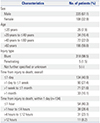1. Trunkey DD. Trauma. Accidental and intentional injuries account for more years of life lost in the U.S. than cancer and heart disease. Among the prescribed remedies are improved preventive efforts, speedier surgery and further research. Sci Am. 1983; 249:28–35.

2. Demetriades D, Murray J, Charalambides K, Alo K, Velmahos G, Rhee P, et al. Trauma fatalities: time and location of hospital deaths. J Am Coll Surg. 2004; 198:20–26.

3. Demetriades D, Kimbrell B, Salim A, Velmahos G, Rhee P, Preston C, et al. Trauma deaths in a mature urban trauma system: is “trimodal” distribution a valid concept? J Am Coll Surg. 2005; 201:343–348.


4. Pang JM, Civil I, Ng A, Adams D, Koelmeyer T. Is the trimodal pattern of death after trauma a dated concept in the 21st century? Trauma deaths in Auckland 2004. Injury. 2008; 39:102–106.


6. Jung KY, Kim JS, Kim Y. Problems in trauma care and preventable deaths. J Korean Soc Emerg Med. 2001; 12:45–56.
7. Kim Y, Jung KY, Cho KH, Kim H, Ahn HC, Oh SH, et al. Preventable trauma deaths rates and management errors in emergency medical system in Korea. J Korean Soc Emerg Med. 2006; 17:385–394.
8. Kim H, Jung KY, Kim SP, Kim SH, Noh H, Jang HY, et al. Changes in preventable death rates and traumatic care systems in Korea. J Korean Soc Emerg Med. 2012; 23:189–197.
10. Jung K, Kim I, Park SK, Cho H, Park CY, Yun JH, et al. Preventable trauma death rate after establishing a national trauma system in Korea. J Korean Med Sci. 2019; 34:e65.

11. World Health Organization. Guidelines for trauma quality improvement programmes. Geneva: WHO Press;2009.
12. Na JY, Park JP, Park HJ, Lee BW, Choi YS, Seo JS. The statistical analysis on legal autopsy performed in Korea during 2012 year. Korean J Leg Med. 2013; 37:198–207.

13. Lee KH. Current status and future perspective of regional trauma center in Korea. J Korean Med Assoc. 2016; 59:917–918.

14. Yoon HD. Background and progress of regional trauma center development. J Korean Med Assoc. 2016; 59:919–922.

15. Lim H, Chang WJ, Kim SH. Distribution of time to death in trauma patients: a review of 11 years' experience at a tertiary care teaching hospital. J Korean Soc Emerg Med. 2001; 12:457–466.
16. Cothren CC, Moore EE, Hedegaard HB, Meng K. Epidemiology of urban trauma deaths: a comprehensive reassessment 10 years later. World J Surg. 2007; 31:1507–1511.


17. Shafi S, Renfro LA, Barnes S, Rayan N, Gentilello LM, Fleming N, et al. Chronic consequences of acute injuries: worse survival after discharge. J Trauma Acute Care Surg. 2012; 73:699–703.

18. Trunkey DD, Lim RC. Analysis of 425 consecutive trauma fatalities: an autopsy study. J Am Coll of Emerg Phys. 1974; 3:368–371.

19. Baker CC, Oppenheimer L, Stephens B, Lewis FR, Trunkey DD. Epidemiology of trauma deaths. Am J Surg. 1980; 140:144–150.


20. Shackford SR, Mackersie RC, Holbrook TL, Davis JW, Hollingsworth-Fridlund P, Hoyt DB, et al. The epidemiology of traumatic death. A population-based analysis. Arch Surg. 1993; 128:571–575.

21. Sauaia A, Moore FA, Moore EE, Moser KS, Brennan R, Read RA, et al. Epidemiology of trauma deaths: a reassessment. J Trauma. 1995; 38:185–193.

22. Meislin H, Criss EA, Judkins D, Berger R, Conroy C, Parks B, et al. Fatal trauma: the modal distribution of time to death is a function of patient demographics and regional resources. J Trauma. 1997; 43:433–440.

24. Mullins RJ, Mann NC, Hedges JR, Worrall W, Helfand M, Zechnich AD, et al. Adequacy of hospital discharge status as a measure of outcome among injured patients. JAMA. 1998; 279:1727–1731.


25. Probst C, Zelle BA, Sittaro NA, Lohse R, Krettek C, Pape HC. Late death after multiple severe trauma: when does it occur and what are the causes? J Trauma. 2009; 66:1212–1217.


26. Claridge JA, Leukhardt WH, Golob JF, McCoy AM, Malangoni MA. Moving beyond traditional measurement of mortality after injury: evaluation of risks for late death. J Am Coll Surg. 2010; 210:788–794.








 PDF
PDF ePub
ePub Citation
Citation Print
Print







 XML Download
XML Download